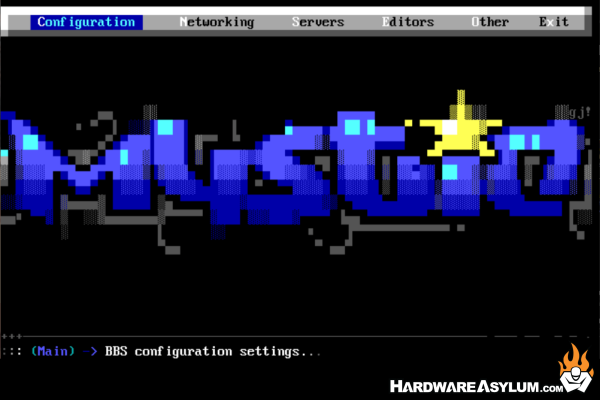A guide for using Dosemu2 to play Door Games on Mystic BBS
Author: Dennis GarciaIntroduction
I know what you are thinking. “Aren’t BBS systems an obsolete relic of the past?”
Why, yes. A BBS or Bulletin Board System was how we communicated before the widespread use of the Internet. These were typically home computers hooked up to the phone line allowing users would dial in to do a variety of things from sending email, interacting with message boards, downloading files, looking at ANSI art and playing games. Aside from the ANSI art, we do many of these things on the modern Internet, in fact “Facebook” is/was a web clone of a typical BBS experience. So, before you claim that it was innovative, just remember there are no original ideas.

While a BBS is no longer relevant there are a number of boards still actively being used. One of the largest is in Taiwan, the PPT Bulletin Board System and was founded by students at the National Taiwan University in 1995.
The website Telnet BBS Guide has an updated list of Bulletin Boards, in fact the Ninjalane Labs BBS was somehow “automagically” added to the list. While, having the extra publicity is nice, they don’t let you edit the entry. ![]()
Synchronet BBS is one of the most advanced boards out there with a ton of features and support for modern and vintage computers. It also has many community-based options including a dedicated IRC network and default access to the DOVE-net message network. It is also open source and has a very robust wiki.
Mystic BBS is another popular option that in is superior to Synchronet BBS in certain aspects but, also lacks many of the modern features we have come to expect. The dichotomy between these to boards is rather interesting when you dive into it.
For me, I have run a Synchronet BBS for well over a year and have grown tired of the difficulty required to make customizations. Because of this I have started to experiment with Mystic BBS and really enjoy how easy it is to customize and modify. I will miss some of the features found on Synchronet but, with support for Python and my background as a web developer I’m pretty sure I can build the missing parts when I need them.
I am creating this guide because there is a TON of misinformation out there related to Dosemu. The biggest of these, there are two versions available. While the names are similar and they share a common code base there are some major differences that can make the existing information difficult to distill.
Dosemu (1) is a linux based DOS emulator that was an extremely popular way to run DOS software on Linux. Synchronet BBS adopted it as the preferred way to play Door Games and other BBS packages followed suit. Active development of Dosemu stopped some time ago and while the package works extremely well, there are several reports of it not working with newer Linux Kernels.
Dosemu2 is another Linux based DOS emulator that started as a modernization of the original Dosemu to address many of the ongoing bugs and allow it to be used on modern platforms including Raspberry Pi.
While the names are similar and they share a common code base there are some major differences that can make Dosemu2 difficult to use. The documentation is “questionable” at best and when looking for information you will get conflicting results stemming from the fact, they are so similar.
We also need to consider that this is open-source software and curated by the maintainers. As with most open-source projects they look to the community for direction but, being that they are also programmers they can choose to reject these suggestions and supplement their own.
Turns out I know a few things about software development, running dev teams and IT projects. Typically, we could call this the curse of “blinders on” and “gold plated scope creep”.
Truth of the matter, the project is a niche of a niche and I fully applaud the team for keeping this project going.
Purpose
For this How-to Guide I will be using Debian 12 (Bookworm) and will be ditching the Comcom64 + fdpp garbage with the intention of using a real command shell.

